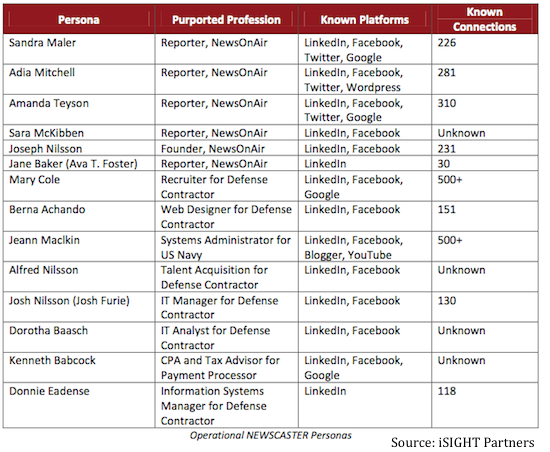
Iranian threat actors, using more than a dozen fake personas on popular social networking sites, have been running a wide-spanning cyber espionage operation since 2011, according to cyber intelligence firm iSIGHT Partners.
The recently uncovered activity, which iSIGHT Partners calls NEWSCASTER, was a “brazen, complex multi-year cyber-espionage that used a low-tech approach to avoid traditional security defenses–exploiting social media and people who are often the ‘weakest link’ in the security chain.”
Using the fake personas, including at least two (falsified) legitimate identities from leading news organizations, and young, attractive women, the attackers were supported by a fictitious news organization called NewsOnAir.org (Do Not Visit) and were successful in connecting or victimizing over 2,000 individuals.
“These credible personas then connected, linked, followed, and “friended” target victims, giving them access to information on location, activities, and relationships from updates and other common content,” iSIGHT Partners said.
Podcast: Inside the ‘NEWSCASTER’ Cyber Espionage Campaign
The attackers used popular social media platforms such as Facebook, Twitter, LinkedIn, Google+, YouTube and Blogger as their attack platform.
While the attack method is not novel, the cyber intelligence firm says that what this group lacks in technical sophistication they make up for in brashness, creativity, and patience.
Working undetected since 2011, iSIGHT Partners said targets included senior U.S. military and diplomatic personnel, congressional personnel, Washington D.C. area journalists, U.S. think tanks, defense contractors in the U.S. and Israel.
Other victims targeted were in the U.K., Saudi Arabia, Iraq and also included vocal supporters of Israel.
“Though it is possible anyone connected to the network was compromised, deliberate attempts to connect with certain entities suggest an interest in political, military, diplomatic and technical intelligence,” the closely held report said.
“Largely this campaign was about credential harvesting and recon,” Stephen Ward, Senior Director of Marketing at iSIGHT Partners, told SecurityWeek.
“They are using those connections to harvest connections to corporate email, harvest connections to personal email, and use those springboards for further lateral [movement], “ he said.
After making connections on social networks, targets were sent spear-phishing messages, often with links asking recipients to log-in to fake pages in order to capture credentials.
Below is a list of some of the accounts/fake personas allegedly used by the attackers.

The campaign also leveraged malware, and while the malware used was not particularly sophisticated, it does includes the capability to exfiltrate data.
“They are sort of disadvantaged from a technological advancement side of things,” Ward said, referring to assumed Irianian attackers. “They have taken to the cyber world the same way you can compare the impact of [improvised explosive devices]. The approach is low cost and does not really use a lot of sophistication from an exploit perspective, but is very effective and ultimately a bit more under the radar.”
“Adversaries such as these are increasingly adept at finding and exploiting opportunities to carry out cyber espionage, even when lacking sophisticated capability,” iSIGHT Partners concluded. “NEWSCASTER’s success is largely due to its patience, brazen nature, and innovative use of multiple social media platforms.”
Organizations involved in critical infrastructure, or who have information that may be of strategic or tactical interest to a nation-state adversary should be concerned about a threat such as this, iSIGHT Partners warned.
We are protective of sources and methods, but we can confirm that these actors did not go unnoticed by some targeted entities and they left significant evidence of their activity throughout the Internet.
Attribution to Iran
According to iSIGHT Partners, there is no direct information showing that the Iranian government is the ultimate sponsor of the campaign, but iSIGH researchers do believe the threat actors are located in Iran.
“[The attackers] maintained a regular schedule, including what appears to be a lengthy lunch break followed by the remainder of the work day,” the report said. “These hours conform to work hours in Tehran. Furthermore, the operators work half the day on Thursday and rarely work on Friday, the Iranian weekend.”
Additional clues, such as the targets the attackers selected, along with additional technical indicators, sparked iSIGHT to believe NEWSCASTER stems from Iran.
iSIGHT Partners said it did coordinate with the FBI to brief government agencies and also notified Facebook, LinkedIn and other social networks.
According to Ward, the identified malicious personas have been removed from Facebook and LinkedIn.
The report from iSIGHT Partners comes roughly two weeks after a report from FireEye, which suggested that Iranian attackers’ methodologies have “grown more consistent with other advanced persistent threat (APT) actors in and around Iran” following cyber attacks against Iran in the late 2000s.
“Iran has steadily increased their focus on cyber espionage over the years, placing significant emphasis on enhancing capabilities following the Stuxnet attacks,” Michael Sutton, VP of Security Research for Zscaler, told SecurityWeek. “The NEWSCASTER attacks, while not technically sophisticated were allegedly quite successful. Often social engineering can be the most powerful tool in an attacker’s arsenal.”
Social networks are a significant challenge for security teams, Sutton says.
“They generally represent a personal communication medium which the organization does not have direct control over and yet can become a source of leaked data or a catalyst for attack as has been seen in the NEWSCASTER attacks. Moreover, due to password reuse, even if an attacker can gain access to credentials used by a victim on personal accounts, there is a string likelihood that the same credentials have also been used for more sensitive corporate accounts.”
“The campaign reported by iSightPartners uncovers what we have known for the last decade — that sophisticated hackers backed by nation states target the weakest link on networks — the user with relatively unsophisticated techniques including spear phishing and social media,” Anup Ghosh, founder and CEO of Invincea, told SecurityWeek.
“Using social media is both a way of establishing false bona fides while presenting a well accepted vector for reaching targets,” Ghosh continued. “A simple LinkedIn or Twitter update with a link, or a timely email from a connection with embedded link or attachment is enough to compromise the intended target’s machine, accounts, data, and enterprise network.”
“This is not surprising as every major foreign adversary is leveraging social media as a cyber attack vector,” added James C. Foster, CEO of ZeroFOX. “Our government realizes this threat is increasing and social media is being used for target reconnaissance and exploitation.”
Listen to the Podcast: Inside the ‘NEWSCASTER’ Cyber Espionage Campaign
Related Reading: Social Media a Key Element for Terror Groups
Related Reading: News Junkies Make Great Targets













